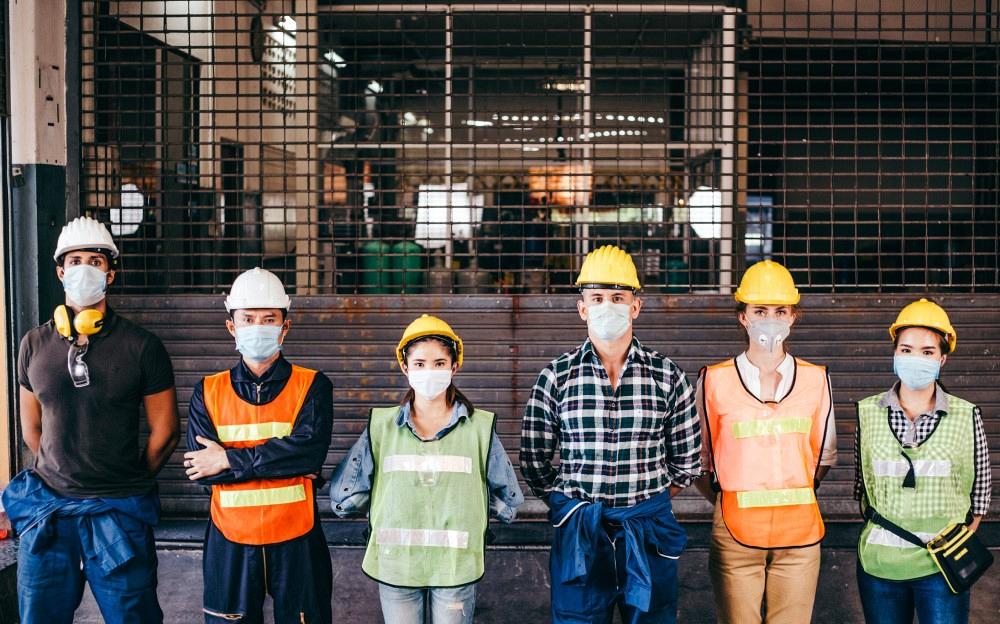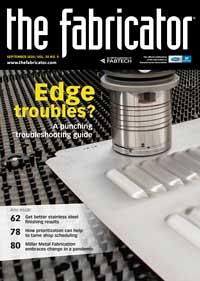Senior Editor
- FMA
- The Fabricator
- FABTECH
- Canadian Metalworking
Categories
- Additive Manufacturing
- Aluminum Welding
- Arc Welding
- Assembly and Joining
- Automation and Robotics
- Bending and Forming
- Consumables
- Cutting and Weld Prep
- Electric Vehicles
- En Español
- Finishing
- Hydroforming
- Laser Cutting
- Laser Welding
- Machining
- Manufacturing Software
- Materials Handling
- Metals/Materials
- Oxyfuel Cutting
- Plasma Cutting
- Power Tools
- Punching and Other Holemaking
- Roll Forming
- Safety
- Sawing
- Shearing
- Shop Management
- Testing and Measuring
- Tube and Pipe Fabrication
- Tube and Pipe Production
- Waterjet Cutting
Industry Directory
Webcasts
Podcasts
FAB 40
Advertise
Subscribe
Account Login
Search
Teamwork in metal fabrication: We’re all in this together
The pandemic-era mantra might do a world of good in the manufacturing industry
- By Tim Heston
- October 3, 2020
- Article
- Shop Management

The pandemic has put the focus on community and the greater good. It’s about the team, not the individual—a sentiment that permeates in some of the metal fabrication industry’s most progressive shops. Getty Images
“We’ve had 60 years of individualism …. The solitary entrepreneur can be the hero. In my mind, we’ve overdone that. If you have 60 years of individualism, you weaken the bond between people, and you weaken the sense of common good and the sense of community. [Pre-COVID-19], we were already shifting away from individualism [and toward community], but the pandemic is accelerating that.”
So said New York Times columnist David Brooks in a virtual edition of the Munk Dialogue, a Canadian public debate forum. In a roundabout way, that shift toward community may do the manufacturing industry, including the business of metal fabrication, a world of good.
As Brooks put it, in the pre-pandemic world, the individual, including the solitary entrepreneur, was the hero. This emphasis of the individual over the group has a negative implication: mistrust. You’ve got to look out for No. 1. And it’s warranted. Over the 50 years of The FABRICATOR magazine’s existence, the industry has endured globalization’s march forward amid a roller coaster of booms and busts, an unforgiving environment for mismanagement. Job security became something your parents enjoyed, a historical aberration of the postwar boom years.
Thing is, the strong have survived for a reason. “We’re in this together” has become a COVID-era mantra, but it’s nothing new to the progressive metal fabricator, the one with extensive cross-training, lean thinking, and a lot of value generated per payroll dollar. It’s not how many pieces per hour a laser cuts or a welder welds, but instead how quickly a purchase order turns into cash. Tie this together with the right automation, and a fabricator grabs market share, perhaps grows its market pie, and the value produced per employee skyrockets.
Growing the market pie is great, but what happens if the pie shrinks dramatically in a matter of weeks? That’s what so many fabricators dealt with during the second quarter. Not all, of course. The pandemic has affected different sectors in different ways. Fabricators in the right supply chains—military, certain medical sectors, e-commerce, warehousing, cloud computing infrastructure—have kept growing throughout the pandemic. But for many in April and May, the market pie shrank in a matter of days as plants shuttered. An inventory draw-down was already expected in many sectors, but the pandemic accelerated that in a big way.
MEC’s experience is a prime example. As No. 1 on The FABRICATOR’s FAB 40 list, published in June, the massive fabricator headquartered in Mayville, Wis., is a bellwether company. Capital expenditures at the $500 million company were $16.6 million for the first half of 2019 alone. It’s an old joke in this business: Buy a bunch of new machines and watch the economy tank. MEC’s second-quarter 2020 wasn’t pretty. Sure, there were some bright spots: Its military contracts remained steady, and some of its business serving the PPE sector quadrupled in volume. Power sport orders remained strong too, with inventory at dealers at 20-year lows.
That said, the bright spots couldn’t prevent dramatic order reductions elsewhere. MEC was already expecting an inventory draw-down. But then came the pandemic. Because its customers’ facilities shut down for five to six weeks, MEC had to temporarily halt production at some of its plants. Business conditions also accelerated the closure of its Greenwood, S.C., plant. The lines that plant produced weren’t lost entirely but just redistributed to other MEC facilities. Overall, second-quarter sales dropped a whopping 57% compared to Q2 2019. May was the low point, June was a little better, July a little better still.
So the old joke came to fruition: MEC bought a bunch of machines and then everything went to pot—right? Well, not necessarily. The company has a strong balance sheet and isn’t overleveraged. And to strengthen its safety net, it amended a credit agreement and expanded its leverage ratio as an “added level of insurance against future macroeconomic events,” according to CFO Todd Butz. Automation also creates an environment where employees are physically distanced—a good thing during a pandemic.
Q2 quoting activity was sky-high, and the company reported that it won a fair amount of takeover business. Opportunities lie in reshoring and nearshoring too, with customers bringing production closer to where the final consumers are. Overall, it’s gaining market share when the market pie is extremely small, which could lead to huge gains when the recovery occurs. But MEC knows that they can achieve those huge gains only if they have the capability to respond quickly to increased demand, hence its capex strategy.
The reasons for automation have evolved. It began with distrust—understandably so, considering what’s happened to manufacturing employment since the 1970s. During FABTECH 2019 I had conversations with company executives who said that, with skilled people retiring and record-low unemployment (remember that?), automation was really the only way the company could grow. Now it’s about giving employees the tools they need to provide value: that is, keep jobs on the move and increase the team’s capacity to produce. The team, from sales through engineering and production, is only as good as its weakest link.
Sure, it’ll be a slog for many for a while. Even so, the pandemic age has brought that “we’re all in this together” sentiment to the fore, and it’s permeating our personal and professional lives. Considering the moves some of the industry’s largest players are making, the post-pandemic era might be an unprecedented time for custom metal fabrication success. But it will be the team, not the individual, that will achieve it.
About the Author

Tim Heston
2135 Point Blvd
Elgin, IL 60123
815-381-1314
Tim Heston, The Fabricator's senior editor, has covered the metal fabrication industry since 1998, starting his career at the American Welding Society's Welding Journal. Since then he has covered the full range of metal fabrication processes, from stamping, bending, and cutting to grinding and polishing. He joined The Fabricator's staff in October 2007.
subscribe now

The Fabricator is North America's leading magazine for the metal forming and fabricating industry. The magazine delivers the news, technical articles, and case histories that enable fabricators to do their jobs more efficiently. The Fabricator has served the industry since 1970.
start your free subscription- Stay connected from anywhere

Easily access valuable industry resources now with full access to the digital edition of The Fabricator.

Easily access valuable industry resources now with full access to the digital edition of The Welder.

Easily access valuable industry resources now with full access to the digital edition of The Tube and Pipe Journal.
- Podcasting
- Podcast:
- The Fabricator Podcast
- Published:
- 04/16/2024
- Running Time:
- 63:29
In this episode of The Fabricator Podcast, Caleb Chamberlain, co-founder and CEO of OSH Cut, discusses his company’s...
- Industry Events
16th Annual Safety Conference
- April 30 - May 1, 2024
- Elgin,
Pipe and Tube Conference
- May 21 - 22, 2024
- Omaha, NE
World-Class Roll Forming Workshop
- June 5 - 6, 2024
- Louisville, KY
Advanced Laser Application Workshop
- June 25 - 27, 2024
- Novi, MI































